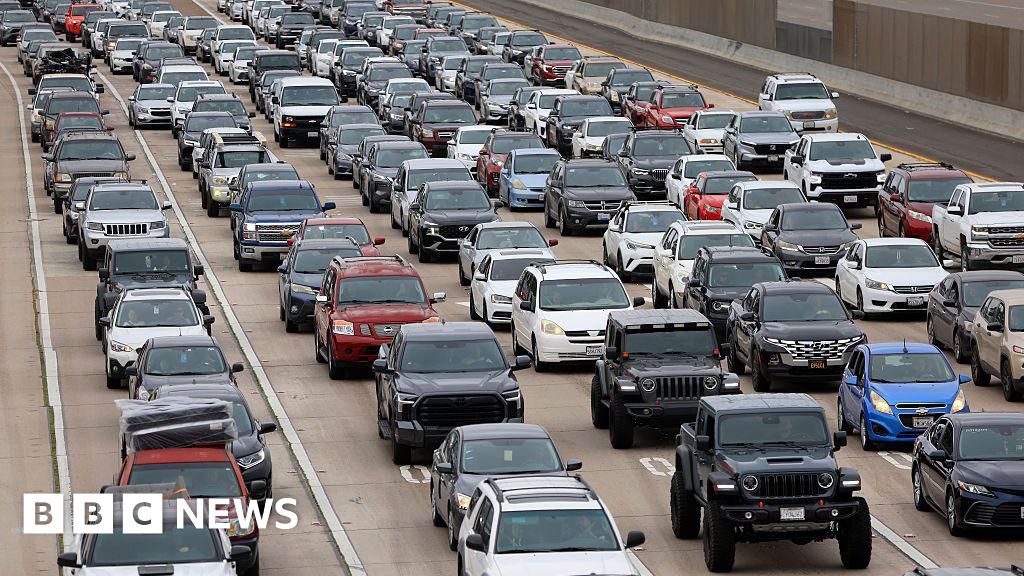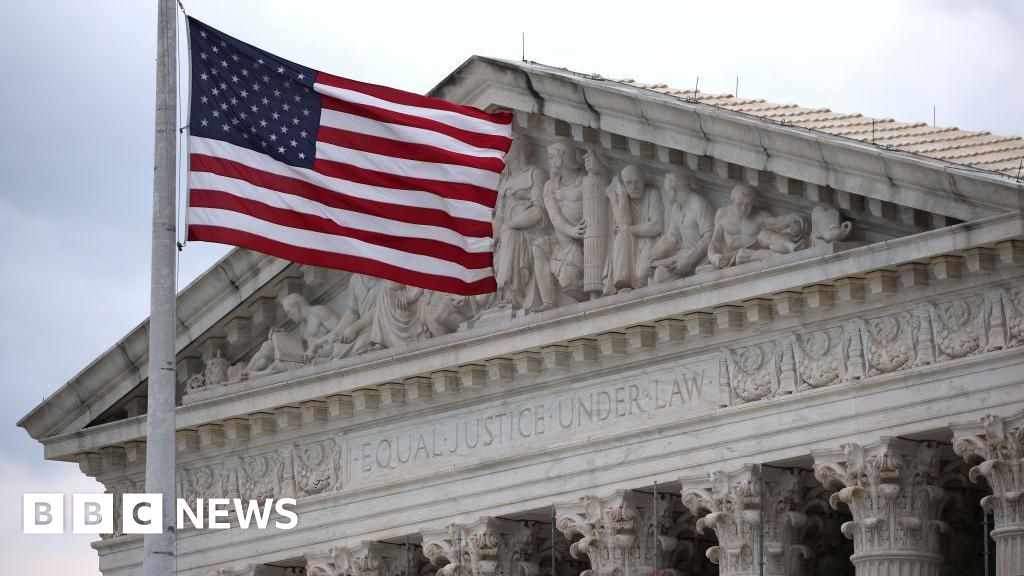ARTICLE AD BOX

By Nadine Yousif
BBC News, Toronto
People across North America will be treated to the view of a lifetime on Monday when a total solar eclipse is set to span across the continent, from Mexico to the very eastern tip of Canada.
Hundreds of events are already being planned for 8 April for eclipse watchers to step outside, look into the sky and catch this rare, astronomical phenomenon.
If you want to be part of the fun, here is our comprehensive guide to where and how to see the eclipse.
What is a solar eclipse?
A solar eclipse occurs when the Moon moves between the Earth or the Sun, blocking some or all of the Sun's rays from reaching the Earth.
The phenomenon is a cosmic event, requiring the Sun, the Moon and the Earth to be in just the right alignment for the Moon to cast a shadow on our planet.
When this happens, the Moon casts two types of shadows.
One results in a partial solar eclipse, which covers only part of the Sun.
The other - and arguably the most spectacular - is called a total solar eclipse where the Sun is entirely covered by the Moon, save for a visible ring of light in the sky.
How rare is a total solar eclipse?
Solar eclipses themselves are not that rare - in fact, there are about two to four that occur per year.
But the likelihood of seeing a total solar eclipse is much rarer. The Earth is quite big, and most of it is covered by oceans. More often than not, humans don't get to see it in person.
In fact, the last total solar eclipse to span the continental US was in 1918, and the next one won't be until the year 2079 - making this upcoming one likely the only one that most of us will get to see in our lifetimes.
What time is it?
The timing of the eclipse will depend on where you are located.
All in all, the phenomenon itself will last two hours. For those in the Eastern time zone, the eclipse will enter continental North America shortly after 14:00 local time (19:00 BST), and exit at 15:46 local time.
The path of totality - meaning where the total solar eclipse will be fully visible - starts at around 11:07 local time in Mazatlán, Mexico, on the Pacific coast.
It will then move northeast, over Texas, the southern parts of Oklahoma, Missouri and Illinois, before making its way to Ohio and along the US-Canada border. The path will end in the Canadian Atlantic province of Newfoundland.
Here is a breakdown of when the total solar eclipse will occur in US and Canadian cities, all in local time:
- San Antonio, Texas: 13:33 Central (19:33 BST)
- Dallas, Texas: 13:40 Central
- Carbondale, Illinois: 13:59 Central
- Cleveland, Ohio: 15:13 Eastern
- Buffalo, New York: 15:18 Eastern
- Burlington, Vermont: 15:26 Eastern
- Montreal, Quebec: 15:27 Eastern
- Fredricton, New Brunswick: 16:33 Atlantic
- Gander, Newfoundland and Labrador: 17:12 Newfoundland time
How long will the total solar eclipse last?
The answer to this question, too, depends on where you are.
According to Nasa, the total solar eclipse will span anywhere from one minute to four and a half minutes.
For people in the US, it will be longest at Radar Base, Texas, right on the US-Mexico border, where it will last a total of 4 minutes and 27 seconds.
In Canada, the total solar eclipse will be the longest in Sherbrooke, Quebec, where it will last 3 minutes and 26 seconds.
Where are the best places to see the eclipse?
Astronomers in the US and Canada have mapped out exactly where the path of totality will be. As long as you're on that path, you should be able to catch the total solar eclipse.
That path is 115 miles (183 km) wide, on average. Some big cities along it include Dallas, Indianapolis, Cleveland and Buffalo.
Niagara Falls will also be a great spot to catch the total solar eclipse, whether you're on the Canadian or American side.
For Canadians, the path of totality includes Hamilton, Montreal and Gander.
People close to the path will still be able to see the solar eclipse, albeit a partial one, and the percentage of the Sun covered by the Moon's shadow will depend on where you are.
Prof Cami noted that people should also account for the weather. If it happens to be cloudy in your city, that can hinder your visibility of the solar eclipse even if you are in the path of totality.
What will the weather be like?
It is still a week away so forecasts can change but some of the most populous areas under the path of totality may have cloudy skies to contend with.
The National Weather Service says that Dallas, for example, will be only partly sunny with a 30% chance of showers. The clearer views could be further north. Carbondale in Illinois is forecast to be mostly sunny with a slight chance of showers. New England looks good too.
Where are gatherings taking place?
There are many gatherings planned across the continent for those who want to share the joy of seeing a total solar eclipse, from the Pacific coast of Mazatlán, Mexico, to a football stadium in Carbondale, Illinois, to the Atlantic shores of Bonavista, Newfoundland.
In the US, Nasa is hosting a series of events, including a viewing in Dallas at the Fair Park Cotton Bowl Stadium, where renowned American astrophysicist Neil deGrasse Tyson will be featured as a guest speaker.
Image source, Getty Images
Some celebrations will span multiple days. In Cleveland, the Great Lakes Science Center will host a festival marking the eclipse that will begin on Saturday and culminate with a viewing of the total solar eclipse on Monday.
These viewings and others are likely to be busy. On the Canadian side of Niagara Falls, officials are bracing for more than one million visitors - the city's biggest crowd ever.
On the US side, Terrapin Point, Prospect Point and the Niagara Falls Observation Tower have all been marked as "prime viewing areas" by National Geographic.
Folks there may also catch another rare sight - the sunny-day rainbow that hovers above the falls will become pink under the eclipse.
Can it be viewed in the UK?
There will be no total eclipse viewable in the UK but British readers can instead catch our live coverage of the event on the BBC website. There will be a livestream to watch it has it happens and regular text and video updates on a live page.
Coverage will begin at 09:00 EST and continue throughout the day, complete with live dispatches from our reporters who will be stationed at eclipse gatherings across the US and Canada.
But there will be a partial eclipse viewable in the UK - about 47% of the Sun is expected to be blocked by the Moon.
How do you safely view the solar eclipse?
If you are planning on watching the total solar eclipse in person, it is recommended that you have the appropriate gear because looking directly at the Sun with the naked eye is dangerous and could result in permanent damage or blindness.
Experts recommend using solar eclipse glasses, which have a special filter that blocks damaging UV rays. These glasses are different from sunglasses, as they block all light entirely except that coming from the sun.
The American Astronomical Society has published a list of vendors who are selling solar eclipse glasses that will work.
If you already have a pair and want to test its authenticity, experts recommend wearing them inside. You should not be able to see anything except for very bright lights which would appear faint.
Image source, Getty Images
Image caption,Total solar eclipses are rare
If you can't get glasses, two pieces of paper and a pushpin might do the trick.
Simply pierce a hole using the pushpin in one piece of paper. With your back to the sun, hold that paper above your shoulder so the sun's rays can shine through that small little hole.
At the same time, hold up the other piece of paper in front of you. It will act like a screen, onto which the Sun's rays will be projected.
Can you take pictures of the solar eclipse on your phone?
You certainly can. However, eclipse photographers recommend a few hacks to make sure your pictures are as crisp as possible:
- Use a sun filter on your phone's camera lens to protect it
- A telephoto attachment clipped onto your lens could also help improve the photo quality
- Switch off the flash before totality, for better pictures and to not spoil experience for others
- Do not zoom in on the eclipse, as your photo might end up grainy
- Use burst mode during totality, a feature that can help you capture that split second magical moment where the Sun is completely covered
- If you want to film a video, use a tripod and make sure your phone is in wide-angle mode
Avoid looking at the Sun directly without eye protection.
If you're using a traditional camera, experts at the American Astronomical Society caution against looking at the Sun through an unfiltered camera lens while wearing your eclipse glasses, as the concentrated solar rays could damage the filter and enter your eyes, causing serious injury.
Is it worth it?
Whether you choose to snap a photo or savour the moment without your phone, the total solar eclipse promises to be an unforgettable experience.
"I've seen three total eclipses before and I have very vivid memories of each of them," Prof Cami said.
"People ask me, 'How is it as a scientist to watch the eclipse?' I mean, you forget that you're a scientist."
It is an "enormously awesome experience", he added, that you can not only see but feel around you.

 1 year ago
66
1 year ago
66








 English (US) ·
English (US) ·